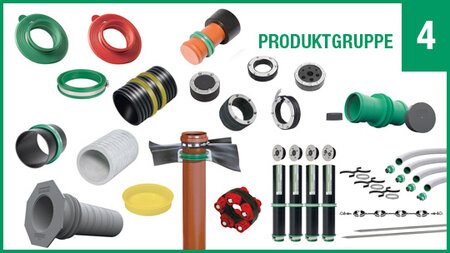Trykkvannstette servicekanaler
Trykkvannstette servicekanaler for rør og tilbehør

Husets innføringssystem for el-, vann- og kommunikasjonstilkoblinger Testet i henhold til DVGW VP 601 (kapittel 4.5)...
Tetningskragene tetter rør og kabler av plast, stål, fibersement og vitrifiert leire mot høy vannsøyle. Gjennomføringer i betongfun...
Hule rør av PVC eller fibersement eller av rustfritt stål for innføring av rør eller rørledninger i en konstruksjon....
Vi tilbyr systemer for vegggjennomføring som kan føres vanntett inn i bygningen....
Vi tilbyr plategjennomføringer i oransjebrun utførelse som PVC-U-systemer (KG) eller som rør av polypropylen (PP), farge grønn. Le...
V2A-pakningsinnsatser i rustfritt stål for fôring av rør og kjerneborehull. Vi tilbyr mange forskjellige typer....
Modulbasert tetning - forhåndsmontert - Rask og enkel installasjon - Testet opp til 30 m vannsøyle - Kan ettermonteres (alle pa...
Plast, damp- og vanntett tetningsmasse for vanntetting av rør- og kabelkanaler under bakkenivå. Også egnet for lekkasjetetting ved...
Her finner du det nødvendige tilbehøret...
Hvilken rolle spiller husinnganger i armert betongkonstruksjoner?
Kravene til vanntette betongkonstruksjoner reguleres av den tilsvarende DAfStb-retningslinjen (WU-retningslinjen). I tillegg til krav til selve betongkonstruksjonen, defineres her krav til fugetetting og forskalingsforankringer eller tilspenningspunkter. Temaet for denne anvisningen er tilsvarende planlegging og utførelse av konstruksjonen for å oppfylle de bruksegenskapene og brukskravene som er spesifisert av byggherren med hensyn til tetningsfunksjonen mot vann.
Et punkt som ikke er tatt hensyn til i direktivet, men som ikke bør neglisjeres for å oppnå en vanntett konstruksjon, er tetting av rør og kabler som føres gjennom betongkomponenten. Med våre ulike husgjennomføringer tilbyr vi den rette løsningen for nesten alle installasjonssituasjoner, uansett om det dreier seg om en rørgjennomføring, et foringsrør eller en husgjennomføring. Tettingsmasse kan brukes til tetting hvis det allerede er vanninntrengning.
Hva brukes husoppføringer til?
Der rør eller andre ledninger føres gjennom betongkomponenter, må de tettes mot inntrengning av vann og/eller gasser som metangass eller den radioaktive radongassen som noen ganger finnes i grunnen.
Ettersom rørene og kablene har andre materialegenskaper enn betongen, og betongen krymper når den stivner, er det fare for at det oppstår sirkulasjon i skjæringspunktene mellom rør og kabler og betongen. Vann eller gasser kan trenge inn i bygningen og skape risiko for skader på konstruksjonen eller til og med på helsen til menneskene som oppholder seg i bygningen.
Hvordan installeres husinnganger?
Avhengig av type husinngang installeres denne enten i forskalingen før støping, eller den integreres i den delen av sokkelen som skal støpes. Det er også mulig å installere den i et kjerneborehull i etterkant ved hjelp av våre ringromstetninger og lenkekjeder. En rørgjennomføring eller andre medieledninger kan tettes ved hjelp av veggkrager.
Det stilles spesielle krav til bruk i landbrukssektoren. Vi har vår JGS-veggkrage (RONDO Protect) i vårt program for dette formålet.





 engelsk
engelsk








